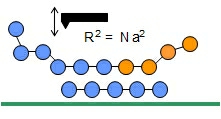Research
Polymers or chain molecules are very versatile materials. Their special mechanical, optical or electrical properties are at the basis of many different applications in which we encounter polymers in daily life. Also biological matter consists to a large part of polymers. Due to their macromolecular character polymers display a number of typical and special properties like e.g. viscoelasticity, rubber elasticity, semicrystallinity and assembly.
Research topics and projects
1. Interface-induced crystallization
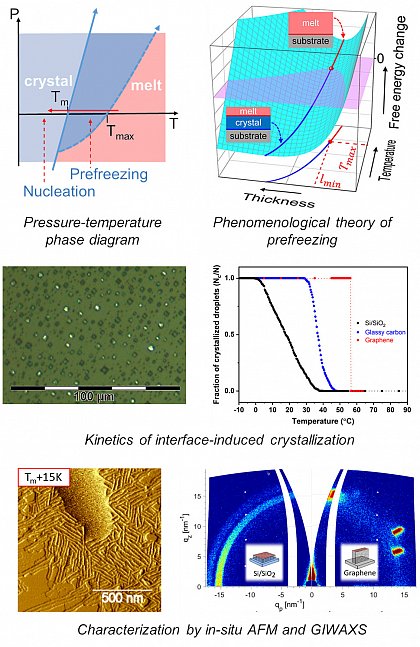
https://pubs.acs.org/doi/10.1021/acs.jpclett.9b00608
Initiation of polymer crystallization at an interface to a solid can strongly affect the semicrystalline morphology and crystallization kinetics, which typically surpasses that of homogeneous nucleation in the bulk. In general, a solid surface can induce crystallization by either heterogeneous nucleation or prefreezing. While heterogeneous nucleation is an activated process occurring below bulk melting point Tm, the process of prefreezing produces a thin crystalline layer above Tm, which thickens upon cooling to Tm. Both prefreezing and heterogeneous nucleation are dependent on interfacial interactions between a polymer and the underlying substrate. By combining experimental and theoretical approaches, our goal is to understand the material parameters that influence the thermodynamics and kinetics of interface-induced crystallization of polymers.
To this end, we investigate the crystallization of thin films and isolated droplets of semicrystalline polymers on solid substrates. We use polarized light optical microscopy (POM), atomic force microscopy (AFM) and grazing-incidence wide-angle X-ray scattering (GIWAXS) as experimental methods.
2. Crystallization of biodegradable polymers
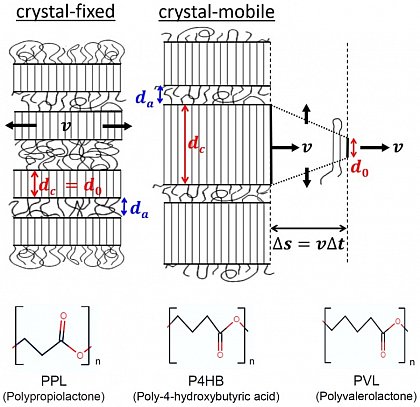
Examples of polyesters with different numbers of methylene groups (CH2)
Biodegradable polymers are needed as a replacement to standard plastics.
However, the mechanical properties of the biodegradable alternatives are
not yet up to the task. This is mainly due to the semi crystalline
structure specific to polymers.
Polymers with regular chemical structure crystallize in a semi
crystalline structure with crystalline lamellae and disordered amorphous
areas in between. The lamellae are some ten nanometers thick but can
reach several micrometers in size laterally.
The resulting nanostructure determines the macroscopic material
properties based on the chemical structure of the chain as well as the
processing conditions. The chemical structure determines the arrangement
of chains as well as the mobility in the crystalline lamellae. Based on
that polymers can be distinguished into crystal-fixed and crystal-mobile
polymers. The semi crystalline nanostructure depends strongly on that
mobility.
We investigate the relationship between semi crystalline nanostructure
and macroscopic properties of biodegradable polyesters with varying
methylene sequence and with and without side groups. The chain dynamics
are investigated by rheology in the melt and by NMR in the semi
crystalline state, respectively. The resulting nanostructure is
investigated mainly by small angle X-ray scattering (SAXS). In order to
analyze the SAXS data we develop and program custom analysis tools.
3. Structure formation in semiconducting polymers
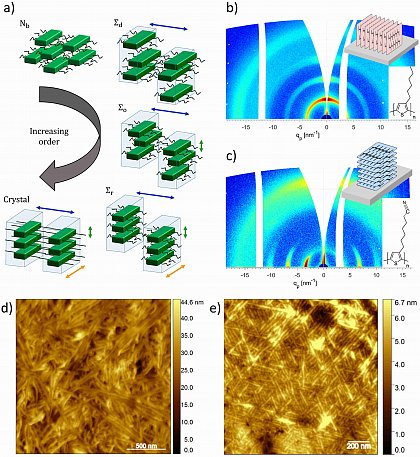
a) Different degrees of order from liquid crystalline to crystalline that can be formed in semiconducting polymers (https://doi.org/10.1021/acs.jpcb.1c10599).
b,c) Scattering patterns of P3HT on silicon (b) with edge-on orientation and P3CNHT on graphene (c) with face-on orientation. The chemical structures of the monomer and the corresponding crystal orientations are shown as insets.
d,e) Atomic force microscopy height images of thin films of P3HT on silicon substrate (d) and P3CNHT on graphene substrate (e).
Semiconducting polymers are promising materials for a wide range of organic electronic applications such as solar cells, transistors and sensors. Since the charge transport properties in semicrystalline semiconducting polymers are anisotropic, the semicrystalline morphology and its orientation in thin films play an important role in the efficiency of organic electronic devices. We study structure formation in semiconducting polymers in bulk and in thin films under the influence of molecular composition and architecture, molecular weight and, in particular, interfaces. Our results show that the interfaces to the substrates and to the vacuum strongly influence the crystallization mechanism, which in turn determines the crystal orientation formed in films of semiconducting polymers. Our goal is to better understand these interface-induced ordering phenomena and to control the crystal orientation in films of semiconducting polymers by tuning the interfacial interactions.
To achieve these goals, the semicrystalline morphology in bulk samples and thin films at ambient and elevated temperatures is studied using various X-ray scattering techniques and atomic force microscopy, while interfacial interactions are analyzed using contact angle measurements.
4. Mechanical properties of semicrystalline polymers
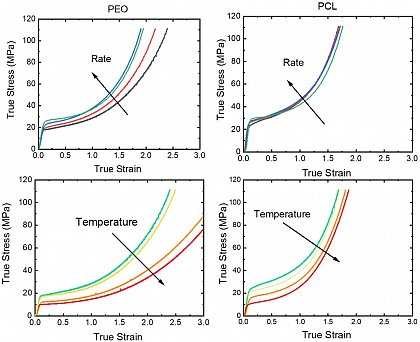
Mechanical properties of semicrystalline polymers
The mechanical properties of polymers are a complex multivariable consequence of intrinsic and extrinsic factors. One of the intrinsic factors that affect it is crystallization; it is well known that the properties of semicrystalline polymers differ greatly from amorphous ones. To establish the effect of crystallinity on polymers, using polyethylene or polypropylene is the standard practice. However, a discussion on the universal behavior of semicrystalline polymers is necessary to explore new materials that address the environmental issues and the application requirements. Chain mobility is one of the critical aspects of many properties of polymeric materials, including mechanical performance; the discussion on chain mobility could be extended beyond the amorphous phase to the crystal; in that case, the influence on the intercrystalline chain diffusion (ICD) that the crystalline segments can express in different time scales. Our research is focused on understanding the influence of the parameters that affect the crystalline morphology and the crystal nature on the mechanical properties.




